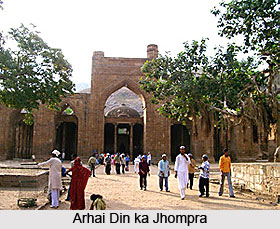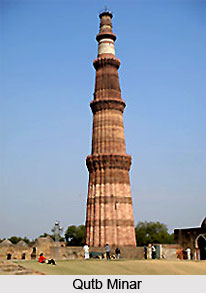 Origin of Islamic architecture in India has its root associated with the invasion of Muslim invaders of the 12th century. During this period, the Ghori King, Muhammad-bin-Sam conquered Delhi and assigned his slave Qutub-ud-Din Aibak as the monarch. It was the beginning of the Slave Dynasty in India. Gradually they were succeeded by khiljis, tughlaqs, Sayyids, Lodhis and Mughals. All were Muslim rulers who brought their own architectural traditions. These styles were based on arches, vaults and domes under the forms of floral patterns along with the unique styles of writing and painting with mosaics in stones.
Origin of Islamic architecture in India has its root associated with the invasion of Muslim invaders of the 12th century. During this period, the Ghori King, Muhammad-bin-Sam conquered Delhi and assigned his slave Qutub-ud-Din Aibak as the monarch. It was the beginning of the Slave Dynasty in India. Gradually they were succeeded by khiljis, tughlaqs, Sayyids, Lodhis and Mughals. All were Muslim rulers who brought their own architectural traditions. These styles were based on arches, vaults and domes under the forms of floral patterns along with the unique styles of writing and painting with mosaics in stones.
The origin of Islamic architecture is the tale of Muslim invasion in India which to a great extent reshaped the whole architectural element of India. The earliest attack in India took place in the 8th century, when much of the lower Indus territories came under the power of the Caliphs of Baghdad, the Arab invaders. This invasion marked the very beginning of the Islamic architecture. The introduction of the glazed tile decoration by the Arabs contoured the initial architectural development of the Islamic architecture. The second attack occurred in the first half of the 12th century, much later the first attack. The Ghazna from Afghanistan attacked Punjab from the way to Lahore, the undivided city of India, where a Viceroy occupied an important group of palaces and government buildings for this purpose; however, these were completely destroyed by the princes of Ghor in the same century. There are few definite records present in the old Punjab region. The ruins of ancient brick and timbered structures provide the clue of the style of buildings that then succeeded. Wooden doors and doorways along with the ornamental elements persisted and were incorporated not infrequently in the Indo-Islamic art which developed shortly afterwards.
 However, the origin of Islamic architecture in India was gradually established during the period of Muslim dynasty at Delhi in the final years of the 13th century. The first Sultan of India of slave dynasty, Qutb-ud-din Aibak built the oldest mosque named Quwwat-ul-Islam in 1195. It was erected on the spacious substructure of a Hindu temple. Materials were taken from the destroyed temple itself. The columns from the temples were used for the walls of the mosque. Its geometric patterns and eight pointed the Hindu influence on arches. It is regarded as a great work of Islamic architecture on Indian soil. The origin of Islamic architecture therefore whispers the saga of an amalgamation of varied styles, shapes and structures. The style of Quwwat-ul-Islam which was initiated by Qutb-ud-din Aibak was carried further by the Delhi Sultanate.
However, the origin of Islamic architecture in India was gradually established during the period of Muslim dynasty at Delhi in the final years of the 13th century. The first Sultan of India of slave dynasty, Qutb-ud-din Aibak built the oldest mosque named Quwwat-ul-Islam in 1195. It was erected on the spacious substructure of a Hindu temple. Materials were taken from the destroyed temple itself. The columns from the temples were used for the walls of the mosque. Its geometric patterns and eight pointed the Hindu influence on arches. It is regarded as a great work of Islamic architecture on Indian soil. The origin of Islamic architecture therefore whispers the saga of an amalgamation of varied styles, shapes and structures. The style of Quwwat-ul-Islam which was initiated by Qutb-ud-din Aibak was carried further by the Delhi Sultanate.
The construction of a mosque, named Arhai-Din-Ka Jhompra at Ajmer in 1205 just after the Qutb Minar again tells the story of the historical development and origin of the Islamic architecture. It was built over the ruins of a Jain monastery that used to be a centre of Sanskrit learning during the Chauhan dynasty. With its distinctive features Qutb Minar, Arhai Din ka jhompra represented a decade of Islamic architectural effort while laying the foundations of Islamic building art in India. The origin of Islamic architecture and later its development made Indian architecture to imbibe Islamic as a culture from a different background of substantial implication.
History reveals the fact that the origin of Islamic architecture during the 12th century was related to an architectural movement which was extending over a great portion of Western Asia. This was the building art of the Saljuqs, an empire with the centre of its activities in Asia Minor. The saljugs absorbed the high culture of this leading Muslim style and built their palaces, mosques, colleges in a well-constructed order. These uncivilized desert people in the course of a short period developed a building art of such excellence in an unusual nature is incredible and outstanding.
Earlier their architectural compositions were largely self-originated, expressive of a community unregulated by previous conventions. The Saljuqs inherited the architecture during the acceptance of Islam religion and infused a freshness and inventiveness into the older procedure, combining it with a new vigour and life. Their constructional usage, choice of material and their masonry shows the expertise in their technical field. This experience was derived from the presence in the country of their choice, of the remains of a considerable number of imposing monuments. The character of building art of Saljuqs in the 13th century was the fusion of two different conditions; one was the imaginative vision of the Asiatic and the other was the scientific ingenuity of the Latin. They had the fusion of Latin character in their architecture due to the presence of Roman artificers who worked under that regime while giving birth to a whole new architectural concept- The Islamic Architecture.
The fusion of the Arabs, the saljugs and later the Mongols silhouetted the origin of Islamic architecture. Quite ideally therefore later the architectural element of Islamic architecture became so much diverse. The combination of white marble and red sandstone carved in patterns of subtle curves, intricate, geometrical designs, and stalactiform devices, which stood as a logo of Islamic architecture murmurs the secrets of its oriental origin. In the Latin character of architecture, they used the Herodian system of stone bonding. Through this process, their masons were able to erect the solid walls, pointed arches of towers and superb vaulting, utilized with such grandeur in the interior halls of the Saljuqs palace-sarais. It is significant that these rows of pillars of massive piers and imposing pointed arches are quite similar with the vaulted aisles of the Gothic cathedrals.
The entire story of the origin of the Islamic architecture from western Asia and its introduction to India is written and preserved in the stones of the monuments of Old Delhi. It may be read in the design and decoration of the Qutb Mosque facade, in the surface treatment of the Qutb Minar, and in the character and construction of the buildings of the mosque gateway known as the Alai Darwaza



















